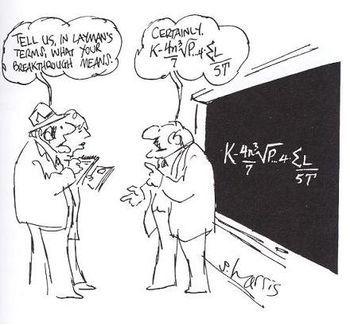As someone who writes a lot of models — many for applied questions in conservation management (e.g., harvest quotas, eradication targets, minimum viable population sizes, etc.), and supervises people writing even more of them, I’ve had many different experiences with their uptake and implementation by management authorities.

Some of those experiences have involved catastrophic failures to influence any management or policy. One particularly painful memory relates to a model we wrote to assist with optimising approaches to eradicate (or at least, reduce the densities of) feral animals in Kakadu National Park. We even wrote the bloody thing in Visual Basic (horrible coding language) so people could run the module in Excel. As far as I’m aware, no one ever used it.
Others have been accepted more readily, such as a shark-harvest model, which (I think, but have no evidence to support) has been used to justify fishing quotas, and one we’ve done recently for the eradication of feral pigs on Kangaroo Island (as yet unpublished) has led directly to increased funding to the agency responsible for the programme.
According to Altmetrics (and the online tool I developed to get paper-level Altmetric information quickly), only 3 of the 16 of what I’d call my most ‘applied modelling’ papers have been cited in policy documents:
- Clements et al. (2011) cited in: How much biodiversity is in Natura 2000? – EU Law and Publications
- Traill et al. (2009) cited in: Climate change adaptation strategies for Australian birds
- Otway et al. (2004) cited in: A review of models and methods for ecological risk assessment
Maybe more of them have modified policy, but I just don’t know.
All of this begs the question — why should we continue writing models if so few of them appear to be useful?
Yes, I’m acutely aware of the reasons why so much science goes by the usefulness wayside in conservation (see here for a discussion of some of the main challenges). In my case, many of my earliest models have failed mainly because I’ve either been naïve or slack on engaging with managers early enough in the development phase. Other models failed to be useful because I also assumed a much higher competency with desktop scenario-building approaches by managers than was realistic. Sure, many of my models have not included socio-economic components (although the ‘economic’ part is usually a lot easier to include; see some examples in the References section below), which might also reduce the realism of implementing any of their recommendations.
I suppose my main lesson from this accumulated experience is that the ideal way to influence policy is to sit down with managers early on and address the questions they want answered specifically. This is a no-brainer. However, the ideal isn’t always possible, but the earlier the involvement happens, probably the better.

I will use this opportunity though to state that it should go both ways. So many conservation interventions fail because — in my opinion — no attempt is made to model possible outcomes under different scenarios before the money is spent and boots hit the ground. Yes, all models are wrong, but some scenarios are more credible than others.
Another problem I fear is that intuitively, many managers know that their budgets are far too small to realize any true benefits, and that these might be exposed by good models. The political need to be seen to be doing something, even if that something is likely to fail, makes evidence-based policy really difficult to justify and implement.
But being afraid of exposing bad policy for what it is should never trump the desire to have the best, evidence-based strategies from the outset. Otherwise, we as a society risk wasting untold billions for no real net conservation benefits.
So, to answer the question above, I have to say ‘yes’, but it requires some planning and collaboration.
References to my ‘applied’ modelling papers
- Venning, KRW, F Saltré, CJA Bradshaw. 2021. Predicting targets and costs for feral-cat reduction on large islands using stochastic population models. Conservation Science and Practice doi:10.1111/csp2.448
- Barnett, LK, TAA Prowse, DE Peacock, GJ Mutze, R Sinclair, J Kovaliski, B Cooke, CJA Bradshaw. 2018. Previous exposure to myxoma virus reduces survival of European rabbits during outbreaks of rabbit haemorrhagic disease. Journal of Applied Ecology 55: 2954-2962. doi:10.1111/1365-2664.13187
- Bradshaw, CJA, TAA Prowse, M Drew, BM Gillanders, SC Donnellan, C Huveneers. 2018. Predicting sustainable shark harvests when stock assessments are lacking. ICES Journal of Marine Science 75: 1591-1601. doi:10.1093/icesjms/fsy031
- Bradshaw, CJA, BW Brook. 2016. Implications of Australia’s population policy for future greenhouse-gas emissions targets. Asia and the Pacific Policy Studies 3: 249-265. doi:10.1002/app5.135
- Prowse, TAA, CN Johnson, P Cassey, CJA Bradshaw, BW Brook. 2015. Ecological and economic benefits to cattle rangelands of restoring an apex predator. Journal of Applied Ecology 52: 455-466. doi:10.1111/1365-2664.12378
- Sequeira, AMM, PEJ Roetman, CB Daniels, AK Baker, CJA Bradshaw. 2014. Distribution models for koalas in South Australia using citizen science-collected data. Ecology and Evolution 4: 2103-2114. doi:10.1002/ece3.1094
- Bradshaw, CJA, IC Field, CR McMahon, GJ Johnson, MG Meekan, RC Buckworth. 2013. More analytical bite in estimating targets for shark harvest. Marine Ecology Progress Series488: 221-232. doi:10.3354/meps10375
- de Little, SC, G Williamson, DMJS Bowman, PI Whelan, BW Brook, CJA Bradshaw. 2012. Experimental comparison of aerial larvicides and habitat modification for controlling disease-carrying Aedes vigilax mosquitoes. Pest Management Science 68: 709-717. doi:10.1002/ps.2317
- Bradshaw CJA, CR McMahon, PS Miller, RC Lacy, ML Verant, JP Pollak, DA Fordham, MJ Watts, TAA Prowse, BW Brook. 2012. Novel coupling of individual-based epidemiological and demographic models predict realistic dynamics of tuberculosis in alien buffalo. Journal of Applied Ecology 49: 268-277. doi:10.1111/j.1365-2664.2011.02081.x
- Clements, GR, CJA Bradshaw, BW Brook, WF Laurance. 2011. The SAFE index: using a threshold population target to measure relative species threat. Frontiers in Ecology and the Environment 9: 521-525. doi:10.1890/100177
- McMahon, CR, BW Brook, N Collier, CJA Bradshaw. 2010. Spatially explicit spreadsheet modelling for optimizing the efficiency of reducing invasive animal density. Methods in Ecology and Evolution 1: 53-68. doi:10.1111/j.2041-210X.2009.00002.x
- Traill, LW, CJA Bradshaw, S Delean, BW Brook. 2010. Wetland conservation and sustainable use under global change: a tropical Australian case study using magpie geese. Ecography 33: 818-825. doi:10.1111/j.1600-0587.2009.06205.x
- Traill, LW, CJA Bradshaw, HE Field, BW Brook. 2009. Climate change enhances the potential impact of infectious disease and harvest on tropical waterfowl. Biotropica 41: 414-423. doi:10.1111/j.1744-7429.2009.00508.x
- Bradshaw, CJA, BW Brook. 2007. Ecological-economic models of sustainable harvest for an endangered but exotic megaherbivore in northern Australia. Natural Resource Modeling 20: 129-156. doi:10.1111/j.1939-7445.2007.tb00203.x
- Bradshaw, CJA, Y Fukuda, M Letnic, BW Brook. 2006. Incorporating known sources of uncertainty to determine precautionary harvests of saltwater crocodiles. Ecological Applications 16: 1436-1448. doi:10.1890/1051-0761(2006)016%5B1436%3AIKSOUT%5D2.0.CO;2
- Otway, NM, CJA Bradshaw, RG Harcourt. 2004. Estimating the rate of quasi-extinction of the Australian gray nurse shark (Carcharias taurus) population using deterministic age- and stage-classified models. Biological Conservation 119: 341-350. doi:10.1016/j.biocon.2003.11.017

